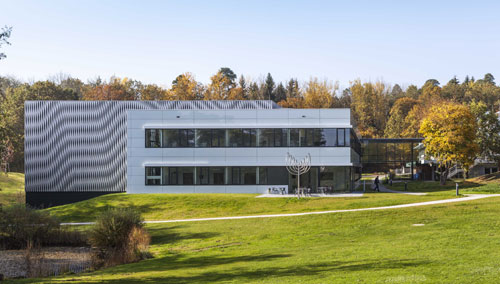
The €25m Precision Laboratory at the Max Planck Institute for Solid State Research in Stuttgart, Germany. (Courtesy: MPI-FKF)
By Michael Banks in Stuttgart, Germany
“There is nothing like this in Germany,” states Klaus Kern, a director of the Max Planck Institute (MPI) for Solid State Research in Stuttgart, Germany, as we walk around the institute’s Precision Laboratory, which opened in 2012 at a cost of €25m.
Kern took me on a guided tour of the the centre, which he has been involved with since its conception in 2008, during a break from attending a symposium celebrating the life of Manuel Cardona, a former institute director who passed away earlier this year.
The building is unique, not only in Germany but worldwide, as it offers researchers a space in which to do experiments that are seismically, acoustically and electrically isolated from the environment.
The 60 m-long experimental hall is where all the action takes place. It is built on a concrete block to dampen outside vibrations, with all of the 11 experimental rooms – each about 36 m3 in size – sitting on an additional 150 tonne concrete block, which itself is reinforced with fibreglass.
Each room is lined with a conducting metal that acts as a Faraday cage to stop stray electromagnetic radiation from getting in, as well as with foam to dampen acoustic vibrations. Finally, the experimental rooms are encased in a “box” made from a single welded piece of steel.
Inside, most of the rooms are equipped with scanning tunnelling microscopes that are used to investigate atoms, molecules and nanostructures at ultra-low temperatures – about 10 mK. There are also some experiments looking at electron transport on the quantum scale, which requires a stable environment cooled to about 1 mK. At such an extreme temperature, any kind of vibration would heat the sample reducing the precision of the experiment.
While the rooms are currently huge, they have been specifically built for whatever possible experiments may be needed in future. “We want to make the lab future-proof,” adds Kern.
Researchers at the Precision Laboratory will be hoping that the facility will allow them to do a lot of exciting science, resulting in papers and perhaps prizes. But at least on that front, the building itself has already beaten them to it, with the design bagging this year’s Hugo Häring award from the Association of German Architects.

Trackback: Physics Viewpoint | Pushing the frontiers of precision